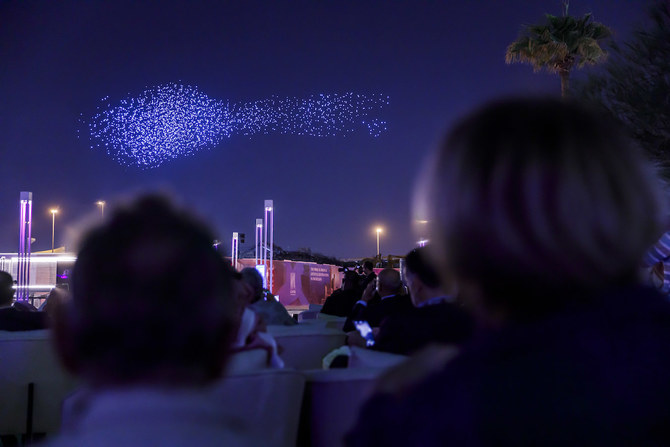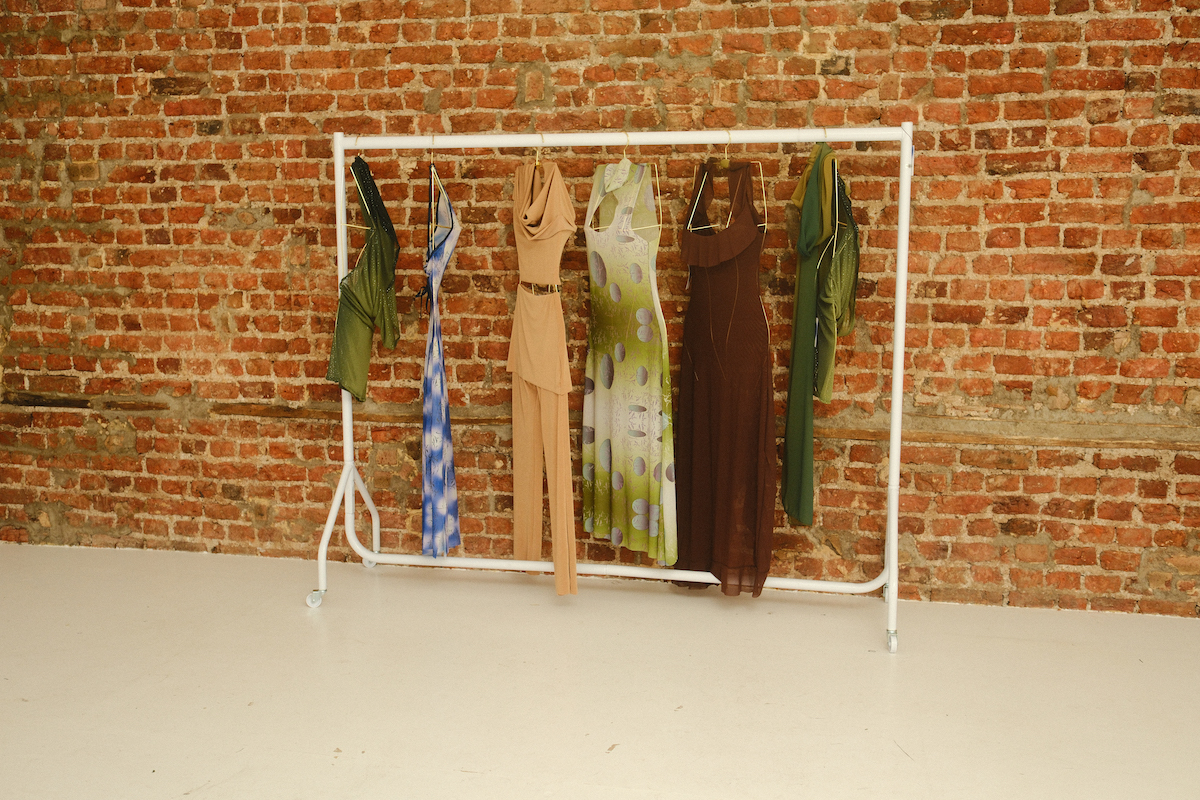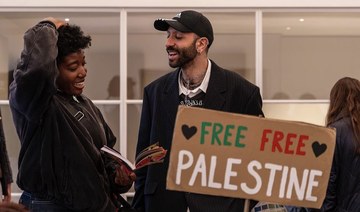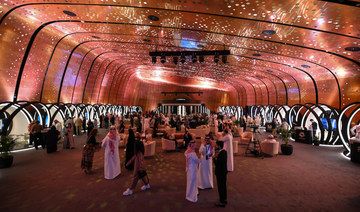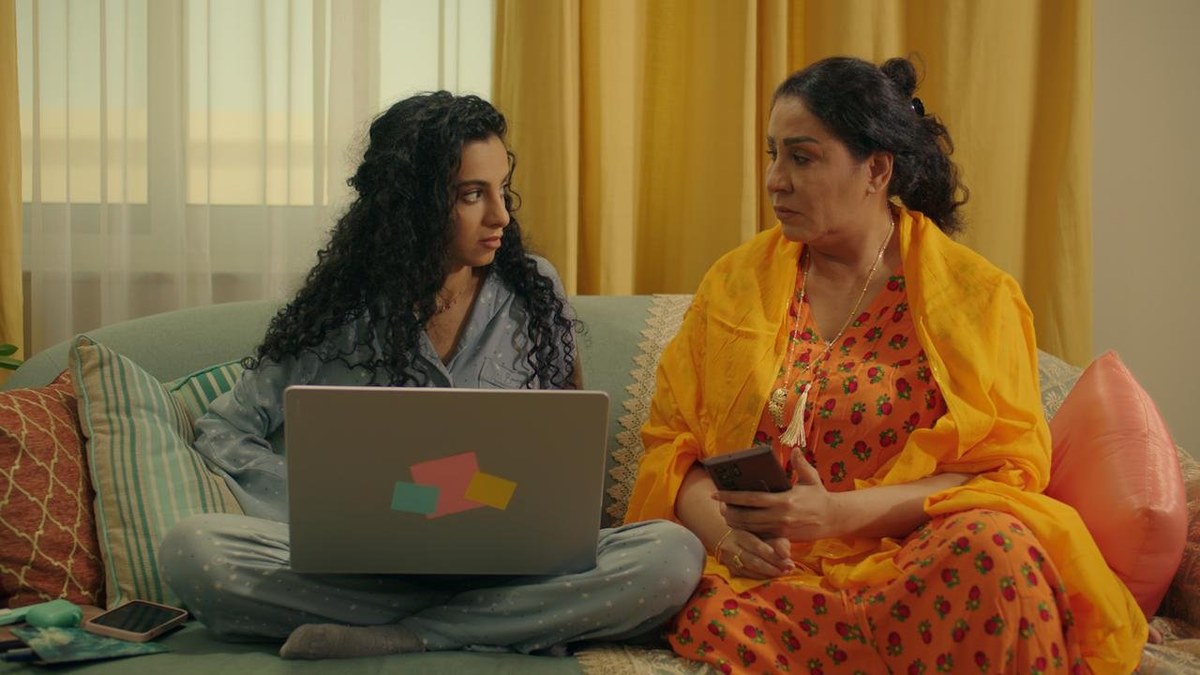RIYADH: “Light is the new ink,” claims UK-based art expert Neville Wakefield, one of the curators of Noor Riyadh, billed as the world’s largest light art festival, which runs in the Saudi capital until Dec. 16.
From fiber optics to artificial intelligence and mobile screens, light, in Wakefield’s opinion, has become a vital tool for modern communication, technology and expression. “The previous century was really defined by print and the written word. This century is defined by light. It is how we write ourselves into the world,” he told Arab News.
Dozens of light-based artworks — from large-scale installations to animated video art — created by around 100 artists from across the world are on display in five public areas, including JAX District and Wadi Namar, in the city, making it an accessible event enjoyed by adults and children. The artists explore a wide variety of themes, including identity, politics, poetry, nature and connectivity.
“With light, you can create something that’s ephemeral and effectively leaves no trace,” says Wakefield. “Light art has always had its moment.”
Here, seven Saudi artists tell Arab News about the inspiration behind their works at the festival.
Hana Almilli

Through her textile installation piece “Journey Through the Ripples of the Sand,” Almilli invites the viewer into “a realm of contemplation and introspection,” comprised of a cocoon with illuminated hanging fabrics, accompanied by an auditory element, with a poem being recited in the middle of a valley, Wadi Namar. Walking through the space is meant to represent a “journey that evokes a sense of conclusion to feelings of alienation, leading to a realization that we are not alone — we are all woven from the same fabric of the sand above and below the earth,” Almilli said. The installation’s maze-like construction is based on “the dance of plants in the desert, echoing the unity and harmony found in nature and within us,” she added.
Abdelrahman Elshahed

A trained calligrapher, Elshahed’s wall-based sculpture is decorated with the words, “Light Upon Light” (in Arabic). It is presented in an abstract, topsy-turvy form, but the calligraphy is based on the “thuluth” style, one of the oldest scripts in Arabic writing.
“What’s beautiful about the formation that I made is that the writing can be read from all sides,” Elshahed explained. “Arabic is usually read from right to left. I tried in this piece to make the writing legible from left to right, right to left, upwards and downwards, and downwards and upwards.” The piece subtly changes color, mostly in neon tones, giving a soothing effect. “In our daily lives, we see many colors, but they have one single source: Light,” he said.
Nawaf Alkuhaimi

Alkuhaimi is actually a full-time physician specializing in ophthalmology. This has impacted “Chromalusion,” his sculptural work for Noor Riyadh, which acts like an optical illusion. The dominant colors are red, white, and green — associated with eye tests. Alkuhaimi placed two mirrors at an angle on a mirrored floor to generate a kind of infinity illusion. “Normally, with mirrors at home, they reflect your own mirror-image. But with these mirrors, you see how people see you in daily life,” explained Alkuhaimi. The piece deliberately creates an unsettling feeling for the viewer, pushing them to be “honest with themselves.” There’s a metaphorical element to Alkuhaimi’s piece: “I would like to invite anyone who sees this project to reimagine themselves — reconsider their steps, dreams, and aspirations,” he said.
Ayman Yossri Daydban

Daydban, who is of Palestinian heritage and resides in Jeddah, showcases a massive wooden “Tree House,” which is part of an ongoing material experimentation for the artist. The structure’s two walls and ceiling are carved with many curious symbols, inviting light into its interior and creating a bedazzling effect. According to a statement published by the festival, the site-specific installation — which Daydban started working on in 2019 — “deconstructs stereotypical narrative related to cultural heritage and identity, as well as the Middle East’s historical relation to Western colonial powers.”
Badiya Studio

Badiya Studio’s “Symphony of Light,” as the name suggests, combines sound and light in an immersive performance art piece. In a darkened room illuminated only by strips of fast-moving lights, a trio of folklore musicians beat on traditional drums known as ‘zeer,’ triggering the light displays. Along with “synthesizing traditional music with cutting-edge technology,” a main purpose of this memorable performance is to “celebrate the rich cultural heritage of Saudi Arabia,” according to an Instragram post from Badiya Studio (Mohammed Al-Hamdan and Mohamed Al-Kindi). The trio performed during the event’s opening weekend, but now visitors can take up the drums themselves and generate their own displays.
Sara AlMutlaq

It took a team of seven individuals working over a period of seven days (10 hours per day), to put together AlMutlaq’s conceptual, wire-heavy artwork “Do we ever really remember the same?” According to AlMutlaq, this piece “questions the memories our minds decide to collect, categorize and archive.” Acting as a “command center of our brains,” this circular installation, which somewhat resembles a map of the world, is made of fiber-optic wires, a mirror, and LED lights. “The attentive viewer will find that the wire is bent, twisted and bolted to tell a story of the relationship between memory and identity through time,” she said. The work also addresses the rapid change Saudi is going through: “How can we be kind to the memories our fathers and grandfathers left behind?”
Sultan Bin Fahad

For his installation “V151ONS,” Bin Fahad took inspiration from the past and the future. The exterior of the ‘building’ resembles a traditional mud house, but inside it there are kaleidoscopic lights in a futuristic trapezoid structure made of stained-glass lightboxes viewable through a rectangular opening. “It’s straight out of a science-fiction novel,” said Bin Fahad. The work explores “themes of time and resonant symbols of Saudi identity put through a prism of ideas,” he added. Those symbols include intersecting swords, palm trees and flowers. Bin Fahad hopes his work will allow the audience “to take away a meaningful understanding of Saudi culture and our constant evolution.”



